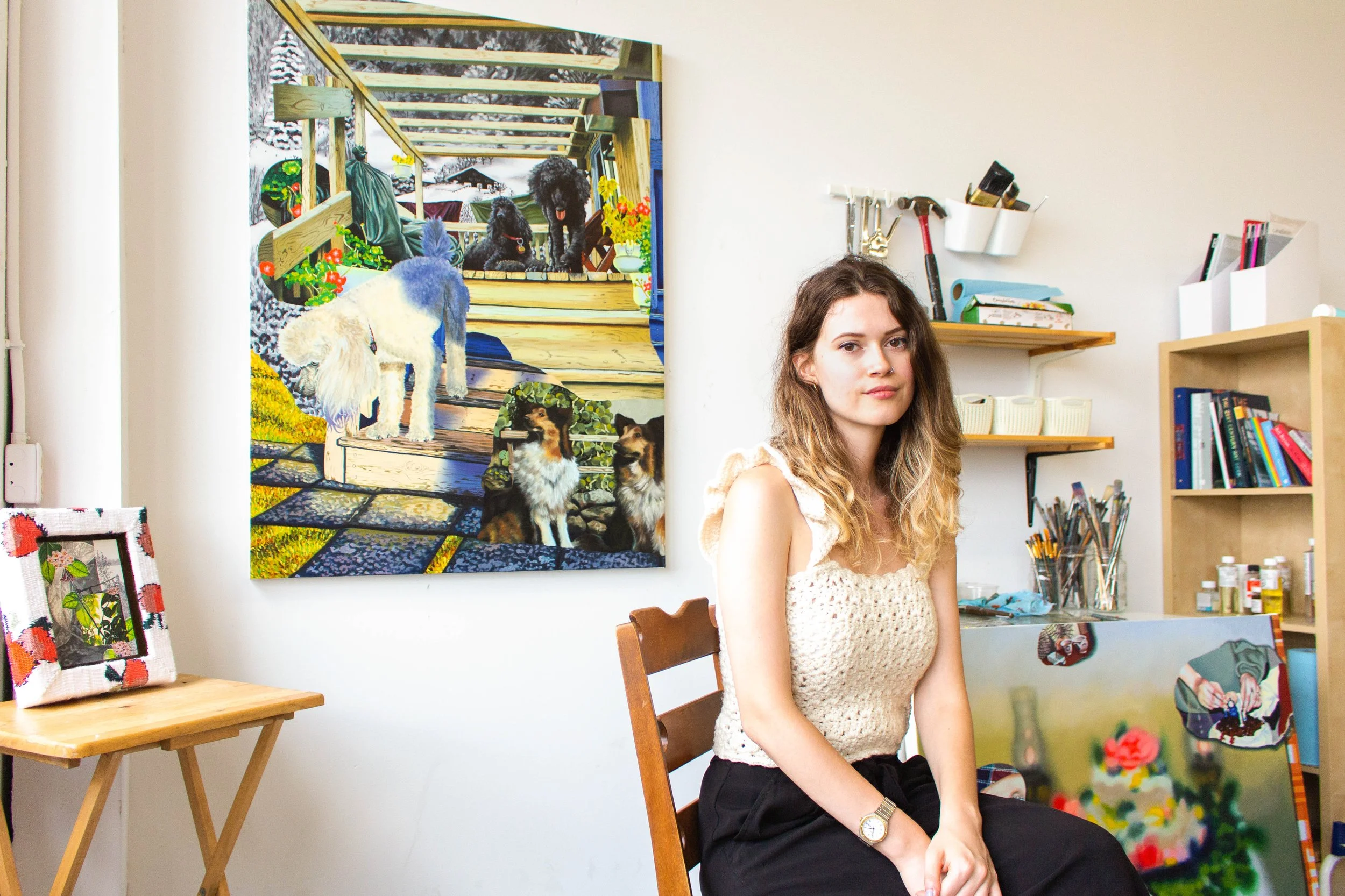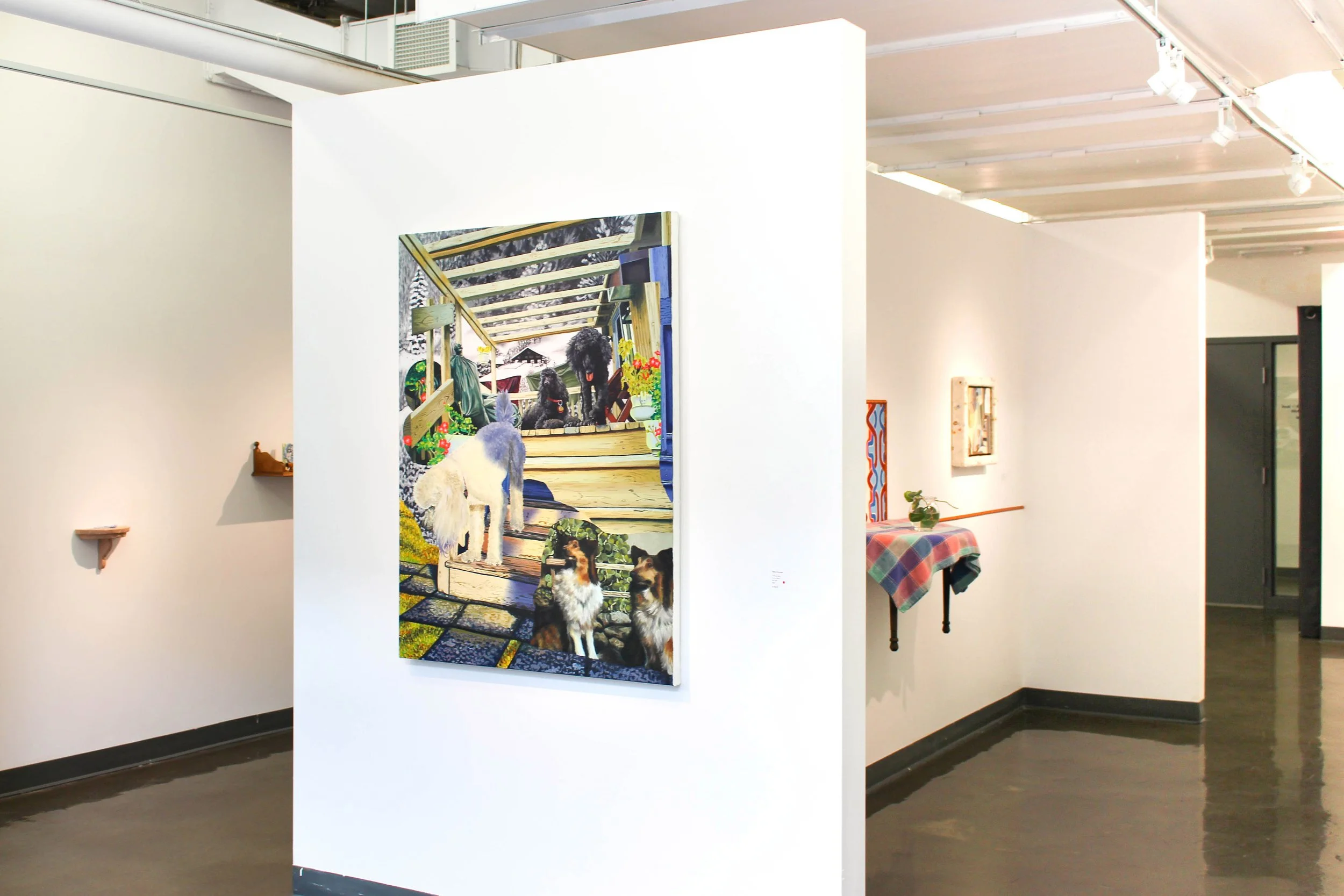Interview with Alexia Mckindsey
Alexia Mckindsey
Alexia McKindsey (b.1996), is a Montreal based artist working with painting, textiles and paper to make eclectic pieces inspired by her childhood memories. Alexia speaks to Alison Poon, editor of FOA, about intergenerational family histories, spaces which memories occupy, traditional painting, and craft techniques in relation to feminism and the home.
INTERVIEW WITH ALEXIA MCKINDSEY AND ALISON POON
Alexia McKindsey (b.1996), is a Montreal based artist working with painting, textiles and paper to make eclectic pieces inspired by her childhood memories. Alexia speaks to Alison about intergenerational family histories, spaces which memories occupy, traditional painting, and craft techniques in relation to feminism and the home.
Alison: What initially drew you to the arts and what are your influences today?
Alexia McKindsey
The Sisters I, 2019
Oil on canvas, 48 x 60 in.
Alexia: I was always encouraged towards creative paths throughout my childhood and later on supported when I decided to formally pursue art. Many members of my family practiced painting as a past-time and I was especially influenced by my maternal grandfather, who being a painter himself, first introduced me to drawing.
I have memories of watching him paint and draw and asking him to draw specific things for me, I was fascinated by all of it. I must’ve been about five years old when I started practicing with him. He really encouraged me towards developing a skill for it and art has stayed with me ever since
My current influences are fairly inwardly focused in that the subject matters fuelling my work are very personal to me and related to documenting my own intergenerational familial histories. The home and its artifacts tends to be the vessel that portrays this, which I find carry the imprint of the lives, memories, traditions and time past from those who occupy it. The majority of the spaces I reference in my work have been occupied by three generations of my family, where I will often juxtapose together images of the same setting but taken several decades apart in order to clearly exemplify a passage of time and the nuances of familial dynamics. Coupled with the depictions of memories, traditions and relics, it makes for a nonlinear encompassing of a collective familial sphere. These are themes I have become naturally drawn to because of their intrinsic closeness to me. I find that there is a world of richness in our own internal spheres that allow for an endless amount of possibilities to be explored within an artistic context.
Alison: You use a variety of materials in your work, including egg tempera and textiles. What attracted you to these more traditional mediums and crafts?
Alexia: As the essence of my work lives very much in the domestic realm, I wanted to able to embody some of the physical elements of that realm a little bit more tangibly and in a more immersive way that can sometimes feel limited by the two-dimensional realm of working with painting and imagery. I see both egg tempera and textiles working as reinforcers for the concepts I explore in my work in different ways. I’ve taken up crochet and hand weaving to reference and repeat patterns that relate to a certain setting or theme depicted in an egg tempera acting as an extension to the work. My work also gravitates towards themes relating to the experiences of women, exploring the identities, legacies and practices of the woman in my life and so that also lends itself into the inclusion of this medium. There's also an inherent connotation between craft, the domestic and canonized female roles, which has also been presents within my own familial context, so it felt like a natural progression in my work to engage in these more traditional crafts of crochet and weaving on a hand loom. On the other hand, egg tempera is a medium that behaves very differently from other painting mediums. It dries instantly once applied to a surface, so it’s worked through a very short, precise and detailed layering of brushstrokes. It's a very delicate and sensitive medium that takes a certain degree of focus to work with as it is not very forgiving. I absolutely adore it, because it allows for a kind of delicate quality and precision that I find perfectly encapsulates my method of working with a multitude of fragmented and detailed imagery.
Alexia McKindsey
'And the Mourning Dove Keeps Cooking' Installation image, 2020
Solo exhibition at galerie AVE in Montreal
It's also a very material, process-based and historical medium, which lends into the overall labour-intensive processes of my practice as a whole. Every aspect of the process, from the surface to preparing the ground to the paint medium is made by hand. I’m also interested in how it’s connotation as a kind of antiquated medium plays into the passages of time I work with and its revitalization into more contemporary contexts.
Alison: Your work is highly detailed with many layered objects - much like a collage. What is your compositional method?
Alexia: I have been slowly building up an archive of old photographic imagery, objects and familial stories, memories and traditions as reference material to inform my work. I want to reference back to the fact that I am using these physical artifacts in my works, and collaging allows me to portray this, as well as pinpoint the nuances of a certain time period through dated photography and trends. I am trying to use this as a vocabulary of sources that I can pick and choose from to create bodies of work. My method of composing works is created through combining and juxtaposing fragments of these elements through collage and layering. I will think through the overarching themes I want to work with in a given work and sift through these archives to identify visuals that stand out to me and then take to composing it, typically through a digital collaging method. This allows me to possess a certain degree of control as to how the general composition of a painting will turn out, how images, shapes and colours will interact with one another. It is a system that really helps me focus on the task of physically creating a work, which I feel is especially important being such a meticulous painter. This makes for a more intentional approach to a larger work, where the overall components of my works are planned out in a very thoughtful manner. To me, concept and physical creation are very separate processes. When I am in the act of creating, I am directly engaged with the physical act of making the work and when I'm sorting through and composing imagery in my preliminary sketches of the work, I am thinking more about the narrative and meaning the work will possess.
Alison: Your quilled paper Wedgwood works have a very personal background to them. Could you explain the process and concept behind them?
Alexia: My paternal grandfather was always an avid collector throughout his life. I have memories from my childhood going into his house and being fascinated with all of the antiques he collected that were displayed in his house that. It felt like you were visiting a museum. His biggest collection had to be that of Wedgwood ceramics which he started collecting in all forms and colours in the 1960’s, accumulated hundreds of them up until his death in 2019.
I later on inherited some of these pieces which became sort of precious to me in their association to him. I began to work on a series of replicating them through quilling where I would sculpt the works directly on the Wedgwood pieces themselves. Quilling is a traditionally craft and hobby-based practice that has a long history but was particularly popularized in 18th century England. At the time, it was a past-time predominantly practiced by women and taught to children, where it remains commonly practiced by to this day. It is a past-time I picked up in my own childhood and I have been intrigued by re-contextualizing it within my current contemporary art practice.
These replicas took on a dual meaning for me. The replicated objects itself were significant of my grandfather and, on the other hand, the paper used in the quilling process was handmade by me using my old baby sheets that were passed down to me from his wife, my paternal grandmother. The series became symbolic of their union. The action of replicating became a means of archiving and safeguarding these familial keepsakes that are now in my possession, of preserving the collective memory and tradition surrounding these relics, as well to commemorate the legacies of these figures in my life. I see the labour of processing the baby sheets into paper pulp as reinforcing the value, care and adoration placed on these fabrics by my grandmother. The act of quilling is significant of the diligence, attention and preciousness my grandfather projected upon the objects he collected.
Alison: How does your family react seeing familiar objects and memories in your works?
Alexia: The reactions I get are always ones of delight and recognition I feel. I think a lot of times, for them, it serves as a glimpse into the past; a way of reminiscing on memories or specific instances of their lives, as well as a recollection of those moments that may have been forgotten. When I work with imagery, I am very detail-oriented and abundant with its inclusion and my family can often pinpoint those exact specificities and imagery that relate to their life and experiences. In some cases, instances of rediscovery can occur where they’ll ask me questions about how the various elements tie into each other and we’ll get into a discussion around the overarching themes and connections present in the work.
Alexia McKindsey
Warm Hues and a Short Fuse, 2020
Egg tempera on masonite, Peruvian highland wool, organic cotton yarn, and stained poplar.
15.5 x 17.5 x 2 in.
The process of composing my works is oftentimes very collaborative as well where I’ll ask family members of mine to identity photographs and the dates and memories that are associated with them. Most of the images I am working with are experiences and moments in time I have not lived through myself, so it's an important part of my process to gain insight from those who have lived through them.
Alison: How has being at home for prolonged periods of time during the Covid-19 Lockdowns affected your work?
Alexia: I feel like the pandemic has actually been an overall positive and uplifting experience for my practice. I feel it has really given me undivided time to focus on my practice in a way I haven’t been able to before. I’ve been able to really dive into the research and material processes of my practice in a more thoughtful way and it’s given me the space to create at a greater intensity. If it weren’t for the pandemic, I probably would not have taken up crochet and weaving, which are now integral parts of my practice, which I really feel pushed and expanded my practice into a much needed direction. While I’m looking forward to a post-pandemic world now, I am thankful for it in the ways it allowed me to grow as an artist.
Alison: Where do you see your practice progressing in the future?
Alexia: I’m excited to continue working with and incorporating textile and craft-based processes into my work. I feel like these mediums are very interesting processes to explore and research in relation to our contemporary context and while I adore painting and will always feel drawn to it, I am becoming increasingly drawn towards creating works that will immerse an audience. I feel like these textile-based mediums, combined with painting have allowed me to combine the pictorial with the tactile in a way that has expanded my understanding of the themes I work with. I hope to continue expanding this way, working more sculptural and interdisciplinary, taking on more ambitious scales and working with the creation of whole environments.




